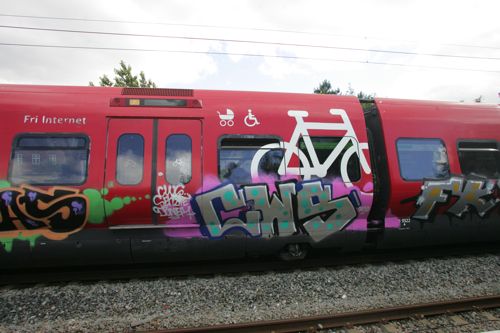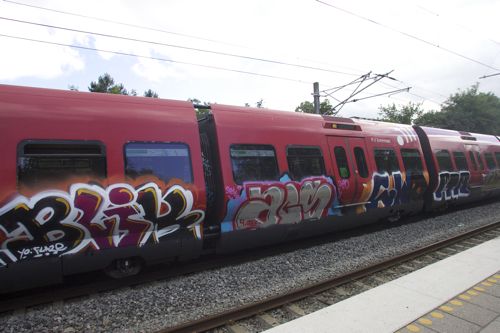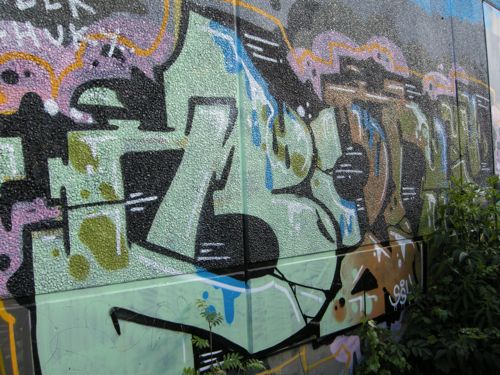
Month: June 2010
BIG PICTURE

In simplest terms BIG PICTURE is just that, a show of big pictures. The pictures – all paintings – are big in terms of size, subject matter, energy, ambition and visual generosity. Many are aggressive or even garish in the color, they are often over worked, heavy layer upon layer of paint, combining dissonant styles and subject matter. These paintings are big in that there is a hell of a lot to look at. Some of the pictures are so big in scope that they seem unresolved, open ended, too big for the canvas they are on.
We (Schneider & Sanford) organized this show to make a case for a young generation of New York picture-making painters who have emerged over the past decade. We asked each of 19 painters that we invited for one big picture that would serve as a strong argument for that artist’s position. Ostensibly, these paintings vary widely and wildly in style, subject matter, and point of view. However, when we look at the show, we like to view it in terms of the big picture.
These are all painters who make pictures of things, in that they all refer to the culture at large; their paintings are about painting, but they are about other things as well. The pictures deal with the biggest of universal themes, like Love, Sex and Death. The big subject matter is often juxtaposed with more idiosyncratic information about subculture or the extremely personal, political or emotional. These are painters of a generation to whom irony and collage-like juxtapositions are second nature, where high/low cultural distinctions are meaningless, to whom technology allows access to every image that has ever been seen or even imagined. These are painters who take advantage of the vastness of their surroundings, the open-endedness of their culture, and this Big Picture is reflected back in their work.
Strange girls //
Panamericana – curated by Jens Hoffmann
Christoph Lohmann
A New Beginning
SHRED

Perry Rubenstein Gallery announces SHRED, an exhibition curated by Carlo McCormick, an independent curator and senior editor of Paper magazine, which will feature collage-based works from a diverse group of artists, some who have pioneered collage as fine art and others who are expanding upon the subversive flavor inherent to the medium. Featured are works in myriad media—from simple layered assemblages of newsprint on paper to lively video animations made from cutout paper silhouettes.
The exhibition will include works by Bruce Conner, a prominent member of the Beat community; California-native, Jess, whose oeuvre includes collages based on alchemy, religion and comic strips; downtown darling Dash Snow; Gee Vaucher, who is central to punk visual culture; and Jack Walls, whose self-portraits incorporate photographic imagery taken by his long-time partner Robert Mapplethorpe.
Provocative new works that were specifically created for the exhibition will be included by artists such as: the collective FAILE (represented by Perry Rubenstein) who will show a ripped painting featuring brand new iconography; Shepard Fairey; Leo Fitzpatrick; Mark Flood; Erik Foss; Swoon; and, Judith Supine. Also to be shown are a finely cut paper collage by Brian Douglas (Elbow-Toe) that resembles intricate painting, while Shelter Serra will present three-dimensional work—red roses cast in white silicone. Video works by Martha Colburn, Tessa Hughes-Freeland and Bec Stupac will be featured, with Stupac premiering a new piece.
SHRED is curated by Carlo McCormick, a prominent New York City-based author, curator, critic and champion of the downtown art scene. McCormick has authored numerous books, monographs and catalogues on contemporary art and culture, including The Downtown Book: The New York Art Scene 1974-1984 published by Princeton University Press which he coauthored. He has lectured and taught extensively at universities and colleges around the United States. His writing has appeared in Aperture, Art in America, Art News, Artforum, Camera Austria, High Times, Paper, Spin, Tokion, Vice and countless other magazines. He has curated exhibitions for the Bronx Museum of Art, New York University, the Queens Museum of Art, and the Woodstock Center for Photography.
Copenhagen Graffiti (Walls)
Copenhagen Graffiti (S-Trains) ///











































